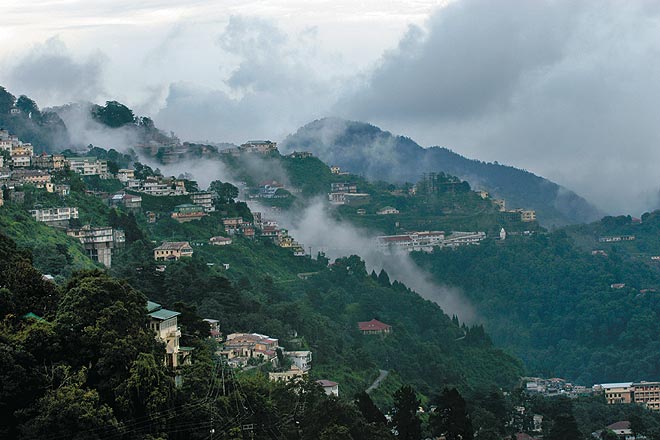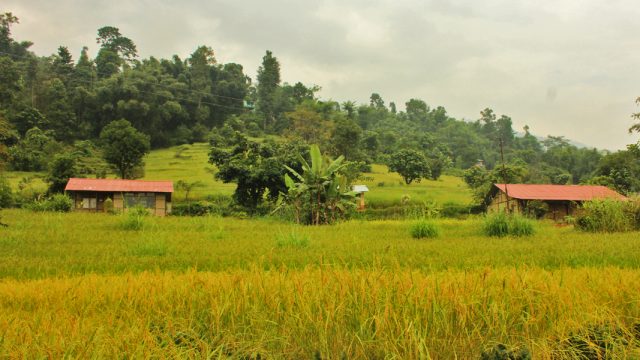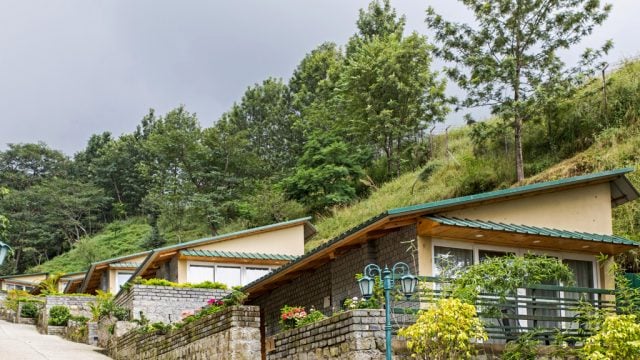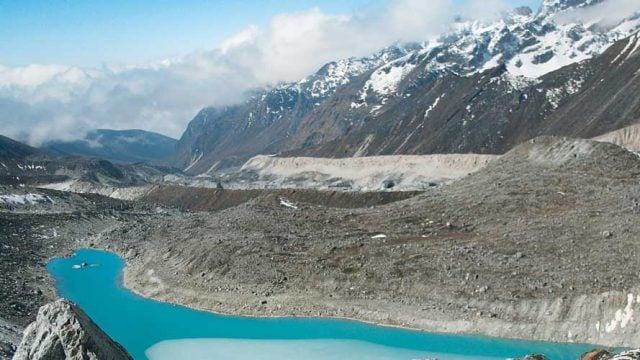Fast facts
State: Uttarakhand
Distance: 269 km NE of Delhi
When to go: Mussoorie is at
Tourist Office: GMVN, Tourist Info Counter, Near Cable Car, The Mall, Mussoorie
Tel: 0135-2632683
STD code: 0135
Getting there
Air: Nearest airport: Jolly Grant, Dehradun (58 km/11/2 hrs).
Rail: Nearest railhead: Dehradun (34 km/ 1 hr).
Road: Route from Delhi NH58 to Roorkee via Meerut, Muzaffarnagar and Purkazi; NH72A to Dehradun via Chhutmalpur and Mohand Tunnel; SH to Mussoorie via Rajpur
On any given day, a carnival-like spectacle unfolds on the streets of this tiny hill-station – its streets clogged by enthusiastic tourists, motorists whizzing by in apocalyptic haste, old men sitting in sunny spots with newspapers and beedis and hollering street vendors vying for attention. Not a single day goes by, be it a weekday or off-season, when the robustness of this town dies down. In fact, as you make your way from the Mall Road Kurla Bazaar to Landour, and further up towards Lal Tibba, the buoyancy of the town overwhelms you. This is Mussoorie (or Mansoori, as the locals lovingly call it), Dehradun’s famous neighbour, known for its plummeting waterfalls, long stretches of winding roads, reputed boarding schools, and hilly swaths of dense deodars and chestnut trees interrupted by mismatched blocks of local settlements and Colonial bungalows.
While most visitors only end up seeing the obvious sights, the real Mussoorie lies beyond what is easily visible. Quit the cars and rickshaws and just walk in the interiors to get a sense of the place. Therein lies its true spirit – serene and with an all-enveloping beauty that lets you be and demands the same.
Things to see and do
After the unsettling, bumpy ride uphill, you know you have arrived when the ornate black iron balustrades start winding along either side of the road. Mussoorie is a walker’s paradise, and for those who are game to explore the city on foot, there are, at short distances, iron benches on extended patios overlooking precipitous terrains.
Mall Road
The aforementioned carnival pretty much defines Mall Road. You start from the Library Chowk, which marks the beginning of Mall Road. With a public library established in 1843, just at the beginning of the thoroughfare and an ornate gazebo called Band Stand (built in 1850, it was the venue for jazz artistes and military bands during the Raj era) set on the corner for shoppers and trekkers, the road zigzags its way until the Tehri Road begins. It’s a long road, which overlaps with areas such as Camel’s Back, Landour or Kulri Bazaar, and is the most comfortable walk-through as compared to the steep slopes of a quainter Mussoorie a few kilometres away.
The Mall Road has the capacity to take up your whole day. There are endless shops selling clothes, utility items, candles, Tibetan teapots and wickerwork among others; gaming parlours keep kids entertained and photographers parade around with local costumes for you to pose in. Kulri Bazaar falls in the fringes of Mall Road. Once done with the commercial attractions, enter the premises of Central Methodist Church, dating from 1885, a stunning building in grey stone and white, adorned with arched doorways and angular roofs. Then you can take the ropeway to Gun Hill, the second highest peak in Mussoorie, instead of walking the 2 km stretch up there.
Gun Hill
A strategic location during Colonial times, from where a cannon was once fired at noon every day, Gun Hill boasts a great view of Dehradun and its surrounding ranges. Take a cable ropeway or walk up here: this is the perfect place to sit with a cup of steaming tea or coffee and contemplate further explorations.
Camel’s Back Road
Just as the commercial paraphernalia fizzles out a little, the popular stretch of Camel’s Back Road begins. Named after the hump-shaped rock formations, this road spreads out in an even, serpentine concrete path, twisting and turning alongside lush forests. The 3-km walk offers an uninterrupted quietude that one can usually only dream of.
Landour
It only takes a second to realise that Landour is in complete contrariety to Mussoorie. About a 15-minute walk from Picture Palace, a landmark that houses a bus stop and taxi stand and marks the end of the commercial Mall Road, Landour is characterised by a gradual waning of Mall Road’s joie de vivre and exemplifies the oft-heard aphorism, ‘Quiet of the hills’. The only stalls belong to vegetable and fruit vendors, along with an odd antique store or two, shops selling walking canes and shoemakers selling bespoke footwear. The main Landour Bazaar is populated with decaying wooden buildings, its roofs layered with stray cables hanging perilously overhead.
Landour has been a military cantonment since 1827 and was a health resort for wounded soldiers who were looked after by nurses, thus giving the main Landour cantonment its name, Sisters’ Bazaar. Cosy houses are set against the backdrop of dense pines and moss-laden cemented railings as you stroll towards Sisters Bazaar. Another quest for explorers is the trek past Char Dukaan to Ruskin Bond’s house, the famous Ivy Cottage, where he lives with his adopted family. First-timers need not feel lost, for literally every soul in the area can guide you to his place. The climb can be a task, considering it’s close to Lal Tibba. Those who want to meet Bond can knock on his door and see if he comes out. In case he is unavailable, fret not. He meets fans at the Cambridge Book Store on Mall Road every Saturday at 4.00 pm.
Lal Tibba
The highest lookout point in Mussoorie at an altitude of 7,510 ft, Lal Tibba (also known as Depot Hill) is home to the military camp as well as the towers of All India Radio and Doordarshan. The view of the postcard-perfect snow-capped peaks and the evanescent misty horizon will not fail to enchant. A lighthouse tower offers a telescope to get a closer look of the Himalayas, Banderpunch, Badrinath and Kedarnath.
Hathipaon: Cloud End and Park Estate
If you want to journey on the proverbial ‘less travelled’ road, head to the stretch on the Dehradun-Mussoorie Road to Hathipaon. Hathipaon is the hidden treasure of Mussoorie, rife with thickly wooded foliage, the trill of forest birds echoing in the air, and even an isolated meadow, where local boys often play cricket. It is perhaps due to its isolation that regular holidaymakers do not frequent this otherwise ideal locale.
Hathipaon is known for mainly two attractions: Cloud End and the Park Estate. Built in 1838, Cloud End, now a refurbished heritage resort, was once home to Major Edmund Swetenham, who received the estate as a dowry. Marking the end of Hathipaon, Cloud End is enveloped by woods and has several trekking trails. More significantly though, there is a fascinating in-house museum which comprises memorabilia such as paintings, crockery and books, among other artefacts. Further up is Benog Wildlife Sanctuary, a part of Rajaji National Park, which offers a chance to spot rare Himalayan birds. The Park Estate, on the other hand, has not been quite so lucky. Despite being home to the famous surveyor and geographer Sir George Everest, the estate, which comprises his residence and laboratory, is a neglected Colonial bungalow, with its walls defaced with time by intrepid declarations of love. Its white structure still stands nonetheless, along with its wooden beams and fireplaces, on the edge of a treeless cliff, giving a view of the Himalayas on one side and the Doon valley on the other.
Where to stay and eat
Located on Mall Road, Fortune The Savoy (Tel: 0135-2632003; Tariff: INR 10,200-20,000; www.fortunehotels.in), dates back to 1902. A favourite with those who enjoy old-world charm, its Victorian architecture is reminiscent of the days of the Raj, yet the facilities are state-of-the-art. Yet another old favourite is Rokeby Manor (Tel: 2635604-06; Tariff: INR 8,000-14,000; www.rokebymanor.com) in Landour. Built in 1840, it is set in a two-acre estate.
The Claridges Nabha Residence (Tel: 2631426/427; Tariff: INR 7,500-14,000; www.claridges.com) was once the Maharaja of Nabha’s summer residence. A single-storey Colonial building, it is set amid 13 acres of private cedar and silver oak forest.
Another heritage option is the early 19th-century Padmini Nivas (Tel: 2631093, 2633123; Tariff: INR 2,400-14,000; www.hotel-padmininivas.com), located below the Mall Road. Rooms overlook the Doon valley.
A more contemporary property, Country Inn & Suites (Tel: 2635601; Tariff: INR 6,000-15,000; www.countryinns.com), is centrally located near Library Chowk. Benog Pines Cottages (Delhi Tel: 011-28032083; Tariff: INR 1,900; benogpinescottages.com), located in the Bunog area of Kempty Falls Road, is about 11 kms from Library Point. The cottage has limited rooms, but a spectacular location.
The Cloud End Forest Resort (Cell: 09634096861, 09412084105; Tariff: INR 6,000-8,000; www.cloudend.com) in Hathipaon, is a cosy retreat with stunning views, and several trekking trails and paths.
Other options include Carlton’s Plaisance (Tel: 2632800; Tariff: INR 3,500-6,500; www.carltonplaisance.com) near the LBSNA Academy, Devdar Woods (Tel: 2632544/644; Tariff: INR 2,000-2,500, INR 4000 for cottages) in Sisters’ Bazaar, and Karma Vilas (Tel: 2632316; Tariff: INR 5,000-10,000; www.karmavilas.com), a 19th-century villa set on an expansive estate dotted with oak and pine trees.
Where to eat
A number of casual dining restaurants on Mall Road offer excellent fare. The Rice Bowl is a particular favourite for its ‘drums of heaven’ and steamed momos, while Kalsang’s Tibetan cuisine is also lip-smacking. For light eaters, Chick Chocolate’s array of comfort food and drinks is an instant favourite. But more popular are its assortment of chocolates, mixed with flavours such as mixed nuts, strawberry and caramel. In Landour, Clock Tower Cafe exhibits a wry sense of humour to go along with its food, with a series of iron plates with comical inscriptions all over.
A noteworthy venture is the Chhaya Café in Char Dukaan, which works with local women and draws a loyal crowd for its homemade cakes and breads. The menu is multi-cuisine.
While walking around, those steaming bhuttas (corn on the cob) sold on every other corner are a ticket to heaven. So are the hot, sugary jalebis and piping hot chaat sold just a little above Mall Road. A vanilla softy never hurts, no matter how knee-deep you are in the snow. Those raring for two-minute wonders can go for Lovely Omelette Centre, recently made famous by a television show (Highway On My Plate), which dishes out eggs cooked every which way.
Mussoorie
Uttarakhand
Leave a Reply
You must be logged in to post a comment.





